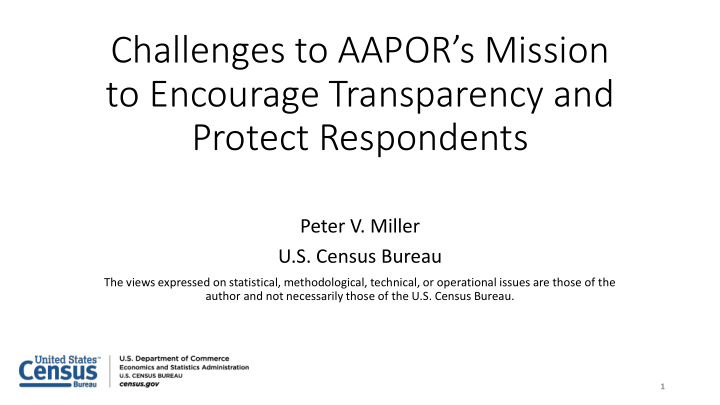



Challenges to AAPOR’s Mission to Encourage Transparency and Protect Respondents Peter V. Miller U.S. Census Bureau The views expressed on statistical, methodological, technical, or operational issues are those of the author and not necessarily those of the U.S. Census Bureau. 1
Transparency • The AAPOR Code of Ethics and the Transparency Initiative enshrine the idea of open science. • Code of Ethics: Good professional practice imposes the obligation upon all public opinion and survey researchers to disclose sufficient information about how the research was conducted to allow for independent review and verification of research claims. • The Transparency Initiative is designed to promote methodological disclosure through a proactive, educational approach that assists survey organizations in developing simple and efficient means for routinely disclosing the research methods associated with their publicly-released studies. 2
Transparency in Other Fields • Center for Open Science: Transparency and Openness Promotion Guidelines • Like AAPOR’s Transparency Initiative, TOP seeks to incentivize open practices in publication – TOP’s focus is on academic journals • Aims to address disconnect between existing incentives for researchers (reward innovation, being first, finding something statistically “significant”) and communal incentives (promoting field’s scientific credibility) • Design, research materials, data and analytic methods disclosure standards – follow, e.g. EQUATOR guidelines for health research 3
Transparency in Political Science • Data Access and Research Transparency project (DA-RT) • Journal Editors Transparency Statement (JETS) • As in TOP guidelines, focus on documentation in connection with journal publishing • Journal editors are gatekeepers, ensuring disclosure of methodological details (but, editors have leeway to exempt submissions from requirements) • Weight placed on analytic and microdata disclosure 4
AAPOR Disclosure Focus • Disclosure provision in AAPOR Code, dating from 1967, is an early instantiation of research transparency principle • Focus on publication of research findings available to the public, often in the media – not just journal publishing • AAPOR journals have secondarily adopted the Association’s disclosure standards • Heavy emphasis on aspects of data collection – comparatively little on analysis and microdata • Most recent Code revision added a provision on microdata disclosure 5
Improving AAPOR’s Transparency Methods • Other fields are not as explicit at AAPOR on data collection • AAPOR has not kept up with others on analytic code and microdata disclosure developments • Journals go furthest, but are not specific and do not provide a mechanism for disclosure of analytic details and data • We should investigate ways for researchers to disclose these essential aspects of methodology securely (a “ dataverse ” or institution) • We should also investigate ways for researchers to deposit all aspects of methodology in a permanent, accessible repository 6
Respondent Protection • AAPOR enshrines the requirement to protect research participants’ Personally Identifying Information • We recognize the right of active participants to be provided with information about how personally identifiable information that we collect from them will be used. • We recognize the importance of preventing unintended disclosure of personally identifiable information. We will act in accordance with all relevant best practices, laws, regulations, and data owner rules governing the handling and storage of such information. • We will restrict access to identifiers and destroy them as soon as they are no longer required, in accordance with relevant laws, regulations, and data owner rules. We will not disclose any information that could be used, alone or in combination with other reasonably available information, to identify participants with their data , without participant permission. • When disclosing personally identifiable data for purposes other than the current research, we will relay to data users any conditions of their use specified in the participant permission we have obtained. 7
Newfound Vulnerabilities • “Personally Identifying Information” is a more expansive category than has been believed. • Re-identification of respondents is possible through linkage with other datasets and through repeated analysis of the survey dataset • We need to keep up with advancements in privacy protection, e.g. differential privacy , • We need to give more guidance on the Code provisions concerning respondent identity protection – What are ‘best practices?’ 8
Achieving a Balance Between Two Essential Aims • Our rules for transparency and for respondent protection need expansion and refinement • We need to work out methods for disclosing analytic code and microdata • We need to work out methods for better protecting respondents when data are disclosed • Efforts in each area must recognize that there is an inevitable tradeoff between disclosure of data and respondent protection • Protecting privacy more means providing less useful data, and vice versa – How do we strike this balance? 9
Thank you peter.miller@census.gov 10
Recommend
More recommend